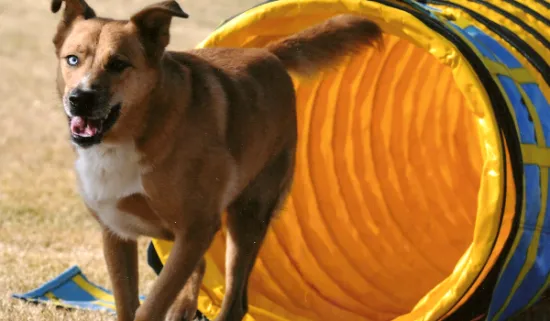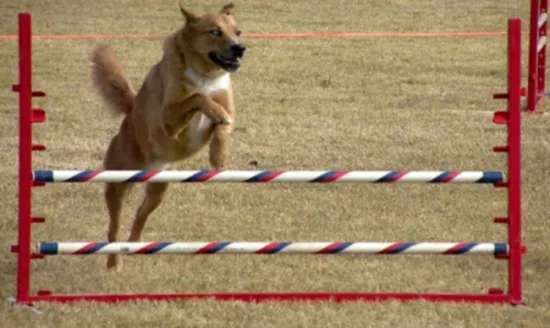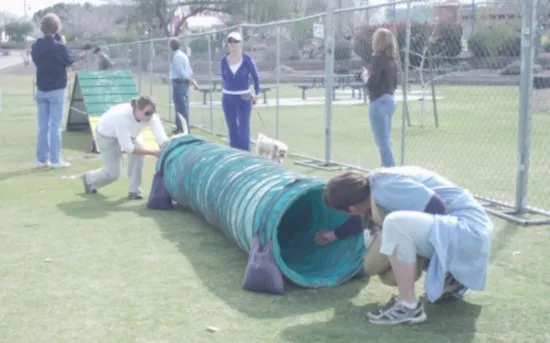“I think if every dog owner engaged in agility training with his or her dog, the dog world would be a better place. Agility is that good, that fun, and that important.” – Sue Sternberg, dog trainer, shelter founder, author.
As a dedicated dog enthusiast and editor at “Dog Care Story,” I couldn’t agree more. My journey into the agility community began as a teenager, profoundly shaping my life. It transformed me into a dog trainer, alleviated my own dog’s separation anxiety, and instilled in me a sense of calm under pressure. Dog agility is more than just a sport; it’s a transformative experience for both handler and canine. If you’re looking for a way to deepen your bond with your furry friend, provide unparalleled mental and physical stimulation, and even solve common behavioral issues, then delving into the world of dog agility might be the perfect path for you. This comprehensive guide for beginners will walk you through everything you need to know to get started, ensuring a rewarding and enjoyable experience for you and your dog.
Why Dog Agility is a Game-Changer for You and Your Dog
Dog agility offers a myriad of benefits that extend far beyond the competitive ring. It’s a holistic approach to dog care that addresses physical health, mental well-being, and the crucial owner-dog relationship.
Benefits for Behavior and Exercise
Many dog owners experience frustration with their dog’s behavior, often not realizing that boredom is a primary culprit. Dogs, inherently bred for work and purpose, require more than just a daily walk to stay happy and well-behaved. Vigorous physical exercise alone, such as a long run, often stimulates the body without engaging the mind, sometimes leading to an even more hyper dog afterwards. This is where agility shines. It provides the perfect blend of physical exertion and mental stimulation, challenging your dog to think, problem-solve, and follow complex commands. This focused activity effectively combats boredom, which is a leading cause of destructive behaviors like digging, incessant barking, or chewing. By giving your dog a “job” in agility, you channel their natural energy and intelligence into a positive outlet, often leading to a calmer, more content companion at home.
Building a Stronger Bond and Communication
At its core, agility training is about developing a shared language between you and your dog. It teaches handlers to use clear, effective body language and subtle vocal cues to guide their dog through a course. This constant communication fosters an incredible bond, building mutual trust and understanding. Your dog learns to pay attention to you, not out of obligation, but because you are the source of exciting challenges and immense fun. This improved communication translates into better off-leash reliability and overall obedience in everyday life. When your dog sees you as their engaging partner in an exhilarating activity, they become more attuned to your directions, making them more responsive and eager to please.
Beyond the Dog Park: Real Engagement
Consider the typical dog park experience: you release your dog, and they often wander off to interact with other dogs, with minimal engagement with you. Returning to you often signals the end of their fun, diminishing your role as their most exciting companion. Agility offers a stark contrast. It creates a dynamic where you are central to your dog’s enjoyment. Every turn, every jump, every tunnel is a joint effort, reinforcing that you are their leader and their most valuable playmate. This deep level of engagement ensures your dog remains focused on you, making training sessions incredibly productive and enjoyable for both parties. The skills learned in agility are also highly transferable, enhancing your overall dog ownership and training abilities, whether it’s teaching new tricks or managing a high-energy pup.
What Exactly is Dog Agility?
Dog agility is a thrilling sport where a handler directs a dog through an obstacle course in a race against the clock. The goal is to complete the course accurately and as quickly as possible.
The Basics: Obstacles and Rules
An agility course typically features 12 to 18 obstacles. These can include tunnels, various types of jumps (standard bar jumps, tire jumps), weave poles (a series of upright poles through which the dog weaves), and the “contacts”—larger obstacles like the A-frame, dog walk, and teeter-totter, which require the dog to touch specific “contact zones” on the ramps. In competition, the dog runs off-leash, and the handler cannot touch the dog or the obstacles. Instead, the handler relies almost entirely on body language, vocal cues, and hand signals to guide their dog through the predetermined sequence of obstacles. Accuracy is just as crucial as speed; faults are incurred for knocking down bars, missing contact zones, refusing an obstacle, or taking obstacles out of sequence.
A Brief History of the Sport
The origins of dog agility can be traced back to England in 1978. It was first introduced as a demonstration sport during the halftime of the Crufts Dog Show. Inspired by equestrian show jumping, the creators designed the course to showcase the natural speed, agility, and responsiveness of dogs. The concept quickly captivated dog owners and trainers, who recognized its potential as a fun and engaging activity for their pets. From this modest beginning, dog agility rapidly evolved into a globally recognized and beloved competitive sport.
Major Agility Organizations
Several sanctioning bodies govern dog agility, each with its own set of rules, course styles, and competition levels. In the United States, the most prominent organizations include the North American Dog Agility Council (NADAC), the American Kennel Club (AKC), and the United States Dog Agility Association (USDAA). For example, NADAC courses are often characterized by their open layouts, emphasizing speed and distance handling, where the dog works further away from the handler. USDAA courses, in contrast, are typically “tighter” and more technically demanding, requiring precise handling. Globally, organizations like the Agility Association of Canada (AAC), the Agility Dog Association of Australia (ADAA), and various national kennel clubs oversee the sport. Exploring these organizations can help you find a club or competition style that best suits you and your dog.
 A dog in mid-air gracefully clearing a jump obstacle on an agility course, guided by its handler
A dog in mid-air gracefully clearing a jump obstacle on an agility course, guided by its handler
Is Agility Right for Everyone?
One of the most appealing aspects of dog agility is its inclusivity. There truly is no such thing as being “too young,” “too old,” or “too out of shape” to participate. Classes and competitions see a diverse range of handlers, from elementary school-aged children to retirees. While being physically fit can certainly be an advantage, it is by no means a prerequisite. Many handlers find that agility training itself helps them get into better shape. From a canine perspective, while herding breeds like Border Collies often dominate the sport due to their innate drive and athleticism, dogs of all breeds and mixes excel. Chihuahuas, Pit Bulls, Huskies, Hounds, and even Great Danes have proven their capabilities. Most sanctioning organizations, including the AKC through programs like Canine Partners, welcome mixed-breed dogs into their agility trials, ensuring that almost any dog can experience the joy of the sport. The most important factor is a dog’s general health and enthusiasm.
Time and Financial Considerations
The commitment to competitive agility training typically involves one hour-long class per week for about six months of the year, coupled with 15-20 minutes of at-home training daily. Additionally, competitive teams might attend one trial per month during agility season. This schedule is often manageable for individuals with full-time work. Financially, competitive agility can be an investment, with costs for classes, trial entries, and travel adding up. However, many local clubs offer significant discounts or free entries in exchange for volunteering at their trials, making the sport more accessible. Fees for junior handlers are also considerably lower. Crucially, competing is not a requirement to enjoy the benefits of agility. Many owners opt to take a few beginner classes and then continue training at home with homemade equipment, or even “homeschool” their dogs entirely. This allows you to reap all the physical and mental benefits without the competitive financial outlay.
 A dog expertly navigating a flexible tunnel obstacle on a practice agility course
A dog expertly navigating a flexible tunnel obstacle on a practice agility course
Navigating an Agility Trial: The Game in a Nutshell
For those considering the competitive side, understanding how an agility trial works can demystify the process. Trials are typically weekend events hosted by local clubs, operating under the rules of a chosen sanctioning organization. Each trial features several different courses or “runs.”
The Walkthrough: Plotting Your Course
The first step for every handler before a run is the “walkthrough.” This is a crucial period where handlers enter the ring without their dogs to memorize the course layout and strategize their handling plan. You’ll observe handlers walking through the course, often using their arms to mimic their dog’s path and muttering commands to an imaginary companion. While it might look peculiar to an outsider, this intense focus allows handlers to meticulously plan every step, ensuring they can guide their dog through the precise sequence of obstacles once the clock starts. A well-executed walkthrough is often the key to a clean and fast run, as it minimizes hesitation and miscommunication during the actual performance.
Understanding Faults and Scoring
Once the walkthrough is complete, the judge and ring crew are in position, and the first team approaches the starting line. The handler positions their dog, gives the “go” command, and they’re off! The team aims to complete the course as quickly as possible while avoiding faults. Common faults, as outlined in most rulebooks, include knocking down jump bars, the dog failing to touch a designated “contact zone” on obstacles like the A-frame or dog walk, refusing or running past an obstacle, taking obstacles out of sequence, or exceeding the allotted time limit. Each organization has specific rules and penalties for these faults, and understanding them is essential for success. The ultimate goal is a “clean run,” meaning no faults were incurred during the performance.
Earning “Qs” and Titles
A clean run without any faults is called a “qualifying run” or a “Q.” Earning a Q is a significant achievement and contributes points to a dog’s official record. While receiving placement ribbons for top scores is exciting, the accumulation of Qs is paramount for progressing in the sport. With a sufficient number of Qs, your dog will earn a “title”—a certificate of accomplishment that signifies their proficiency at a certain level. These titles are then appended to your dog’s registered name, creating a distinguished and often lengthy string of letters that proudly display their achievements in the agility world. These titles not only validate your team’s hard work but also serve as milestones in your agility journey.
 A dog and handler practicing weave poles, an essential and challenging agility obstacle
A dog and handler practicing weave poles, an essential and challenging agility obstacle
How to Start Your Agility Journey
Embarking on your agility journey can be done in several ways, whether through structured classes or independent training at home. The most crucial first step is to connect with the agility community or gather the right resources.
Finding a Local Agility Club
For many, the best way to get started is by finding a local agility training club. Clubs offer structured classes, expert instructors, and access to proper equipment. They also provide a fantastic opportunity to meet other agility enthusiasts, learn from experienced handlers, and observe trials firsthand. Websites like Clean Run magazine often provide searchable databases to find clubs near you. Additionally, the websites of national sanctioning organizations (such as USDAA, NADAC, or AKC in North America) typically list member clubs and upcoming events. Attending a local trial as a spectator is an excellent way to experience the sport’s atmosphere, see different teams in action, and even chat with handlers (when they’re not preparing for a run!) to get insights into their club.
“Homeschooling” Your Dog: Backyard Agility
If competitive training isn’t your immediate goal or if local clubs are inaccessible, “homeschooling” your dog with backyard agility is a fantastic and fun alternative. You can construct many obstacles yourself using readily available materials like PVC pipes for jumps and tunnels. Simple household objects can also be creatively repurposed to create an engaging course. This approach allows you to train at your own pace and focus on bonding and basic skills without the pressure of competition. However, it’s vital to prioritize safety, especially regarding jumps. Never allow puppies or young dogs (under 12 months for small breeds, 18-24 months for larger breeds) to jump over obstacles with any height, as their bones and joints are still developing and prone to serious injury. Always consult your veterinarian before starting any new strenuous physical activity with your dog.
 A small group of dogs and handlers engaged in an outdoor agility training class, learning new skills
A small group of dogs and handlers engaged in an outdoor agility training class, learning new skills
Essential Resources for Self-Training
For those embarking on a self-guided agility journey, a wealth of resources is available to support your efforts:
- Building Equipment: Websites like Canine Crib and DogPlay offer instructions for building simple, cost-effective agility equipment. For purchasing durable, affordable equipment, Affordableagility.com is a recommended source.
- Books: Classic guides such as “Introduction to Dog Agility” by Margaret Bonham and “The Beginner’s Guide to Dog Agility” provide comprehensive information on techniques, training, and understanding the sport.
- YouTube Channels: Channels like Agilitynerd offer extensive libraries of handling exercises and training tips. Pamelamarxsen’s agility videos playlist is another excellent resource for various training how-tos relevant to agility.
- Online Resources: Websites such as AgilityNerd.com and CleanRun.com provide articles, forums, and additional training materials. Specific articles like “Proper Jumping for Agility” and “Take it to the Ground” (explaining flatwork) are invaluable for learning safe and effective techniques.
- Community: Engaging with online forums and social media groups dedicated to dog agility can offer support, advice, and shared experiences from other self-trainers.
Conclusion
Dog agility is a truly rewarding endeavor that offers unparalleled benefits for both you and your canine companion. From strengthening your bond and enhancing communication to providing essential mental and physical stimulation, the sport addresses many aspects of a dog’s well-being. Whether you choose to pursue competitive titles or simply enjoy casual training in your backyard, the journey will undoubtedly foster a deeper connection and a happier, more well-adjusted dog. Remember to prioritize safety, especially for young dogs, and seek guidance from professionals or reliable resources as you progress. Embrace the challenge, enjoy the process, and witness the incredible transformation agility can bring to your dog’s life—and yours.
Start your adventure today and discover why “Dog Care Story” believes that engaging in the beginner’s guide to dog agility can change your life. Share your progress and stories with us!
Further Resources
- Agility Organizations (North America):
- United States Dog Agility Association: http://usdaa.com
- North American Dog Agility Council: http://nadac.com
- American Kennel Club Agility: http://www.akc.org/events/agility/
- Agility Association of Canada: http://www.aac.ca/
- Agility Organizations (Australia):
- Agility Dog Association of Australia: http://www.adaa.com.au/
- NADAC Australia: http://nadacaustralia.com
- Agility Clubs (United Kingdom):
- Agilitynet UK Clubs Listing: http://agilitynet.co.uk/activepages/clubs.asp
- Worldwide Organizations:
- Wikipedia – Dog Agility Worldwide: http://en.wikipedia.org/wiki/Dog_agility_worldwide
- Equipment Building:
- Canine Crib – Build Your Own Agility Equipment: http://www.caninecrib.com/dog/training/agility-course.asp
- DogPlay – Just for Fun Agility: http://www.dogplay.com/Activities/Agility/index.html
- Affordableagility.com: http://affordableagility.com
- Books:
- Introduction to Dog Agility (Margaret Bonham): http://www.amazon.com/Introduction-Dog-Agility-Margaret-Bonham/dp/0764141384/ref=sr_1_2?ie=UTF8&qid=1340842557
- The Beginner’s Guide to Dog Agility: http://www.amazon.com/The-Beginners-Guide-Dog-Agility/dp/0793805465/ref=pd_sim_b_1
- YouTube Channels:
- Agilitynerd: http://www.youtube.com/user/agilitynerd
- Pamelamarxsen’s agility videos playlist: http://www.youtube.com/playlist?list=PLA09DB316F4F1DDD2&feature=plcp
- Online Articles & Resources:
- Proper Jumping for Agility: http://www.boxerworld.com/forums/agility-obedience/26425-proper-jumping-agility.html
- Take it to the Ground (Flatwork): http://www.powerpawsagility.com/articles/Takeittotheground.html
- AgilityNerd.com Blog: http://agilitynerd.com/blog/
- CleanRun.com: http://cleanrun.com
- Agility Skills You Can Teach at Home: http://www-personal.ksu.edu/~may/Skills
